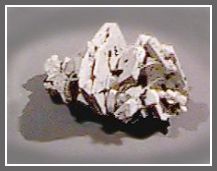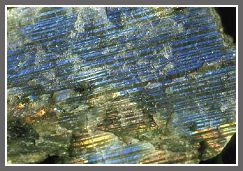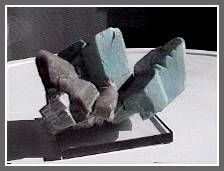By Anita D. Westlake.
libawc@emory.eduOriginally Presented to the Georgia Mineral Society's Mineral Section Meeting
 |  |  |
| Orthoclase | Labradorite | Amazonite (blueish crystals) |
The word feldspar literally translates to: feld, meaning
field, and spar, meaning "easily cleaved material". It
refers to any of several crystalline aluminosilicate minerals
found in abundance in the earth's crust.
Minerals in the feldspar group are found in many places
throughout the world, in pegmatites, even meteorites, and
pass through all rock and ore-forming processes: igneous,
metamorphic, hydrothermal and sedimentary, yet only rarely do
they occur as gemstones. Feldspars are the most diversified
and the most extensively investigated minerals on earth,
though they only recently commanded the attention they
deserve. It wasn't until the middle of the eighteenth
century that minerals in this group were even vaguely
mentioned in Wallerius's popular work "Mineralogy" written in
1753. They were briefly described as varieties of a "spar
dense and lustrous" distinguished only by their colors of
white, gray, and the occasional red. It wasn't until the end
of the 18th century that serious crystallographic and
chemical research began. Today, at least 40 varieties of
feldspars have been identified, with a dazzling array of
colors and distinctive features.
Feldspars have a specific gravity which varies between
2.5 to 2.7 depending on the chemical composition. The
hardness ranges from 6 to 6.5. Its fracture, other than
along the cleavage planes, is subconchoidal to uneven. Most
feldspars crystallize from a melt in igneous rocks. Their
crystals are tabular, flattened and most are complexly
twinned.
All feldspars have certain physical characteristics in
common: they have 2 good easily developable cleavages, one
which is perfect, usually known as the basal plane. Here, the
luster is pearly and the from the cleavage cracks parallel to
this face, brilliant iridescent colors are sometimes
reflected. The second cleavage, less perfect than the first,
is parallel to the pair of faces which truncate the acute
sides of the prism. The cleavages of monoclinic and triclinic
feldspars are essentially the same with the following
exception: the monoclinic crystals have cleavage planes that
are exactly perpendicular to each other, giving them the name
"orthoclase" which means "cleaving at right angles." In
triclinic feldspar, the two cleavage directions are not quite
at right angles. These are referred to as "plagioclase",
meaning obliquely cleaving.
The presence of lamellae, which are thin, platelike
layers within the crystalline structure, gives rise to the
"Schiller Effect". This is an iridescence caused by the
scattering of light between the layers. In Labradorites, the
Schiller Effect is best developed, creating a lovely color
play in shades of green, blue, gold and yellow. The color
may be homogeneous or vary within a single feldspar crystal.
Research is currently being conducted on lower quality
plagioclase feldspar mined in Arizona to see if gamma
radiation will produce a color shift or enhancement. Initial
tests suggest this possibility exists.
POPULAR STONES IN THE FELDSPAR GROUPAMAZONITECRYSTAL SYSTEM: Triclinic
HARDNESS: 6
COLOR: Light green, blue-green or bluish with a mottled
appearance and sometimes a fine crisscross network of light
striations (which help to distinguish it from certain jades
and beryls.)
Originally called "Amazonstone" because it was found
near the Amazon River, this term was also used to describe
Nephrite.
GENESIS: It is found in metamorphic rocks, intrusive magmatic
rocks and pegmatites. The finest examples of Amazonite in
the United States are found in Amelia Courthouse, Virginia.
Pikes Peak, Colorado also boasts a variety of Amazonite found
in cavities in a coarse pegmatite granite with smokey quartz
crystals, often of huge size.
LORE: Worn by gamblers to attract money. It was also used by
anyone taking a chance to ensure success.
LABRADORITECRYSTAL SYSTEM: Triclinic
HARDNESS: 6-6.5
COLOR: Blue, green, yellow are the most common colors, with
copper-red being the most rare.
The most magnificent of all the feldspars, Labradorite
occurs on the coast of Labrador, Canada. Although it is
often a dingy, dark gray, the brilliant play of colors and
unexpected flash combine to make this a most remarkable
stone. It is a lime-soda-feldspar, comprised of approximately
55% silica, 25% alumina, 2% ferric oxide, 11% lime, 4% soda,
with a touch of Potash. Feldspars with this composition are
referred to as Labradorite, whether they come from Labrador,
Madagascar, Scandinavia, or the United States.
The stone is cut, not with facets, which would destroy
its reflected rays of color, but either perfectly flat or
with a slight convex surface. It must be cut parallel to the
reflecting surface, or no play of color will be seen. The
sudden appearance and disappearance of brilliant colors is
its most striking feature and gives us the word
"Labradorescence".
An interesting specimen of Labradorite from Russia
displays a perfectly recognizable image of Louis 16th. The
head is of the finest azure-blue and stands out from a
golden-green background. It is topped by a beautiful
garnet-red crown with a border of rainbow colors and a small,
silvery shining plume. In 1799 the owner received one
quarter of a million francs for it.
It was customary to use Labradorite in the
representation of objects with a metallic color such as the
iridescent wings of butterflies. In the beginning of the
19th century, reliefs of Mandrill baboons were very much in
vogue, and Labradorite was used to color the snouts of these
most colorful animals.
GENESIS: Widely distributed throughout the United States, it
is found in great abundance in Lewis and Essex Counties in
New York in situ as boulders in glacial deposits. These
boulders can be traced all the way down to Long Island and
New Jersey, and were so numerous in one river in Lewis
County, it was named "Opalescent River". Large quantities
were quarried at Keesville, NY for monumental and building
purposes. It is found in Pennsylvania, Arkansas and North
Carolina, but the gem quality variety is only found in
Labrador, Canada and Finland.
LORE: In ancient times, Labradorite was considered a general
"good luck" stone. In recent times, it has become popular
among New Age devotees as a spiritual, psychic-enhancing
gemstone.
MOONSTONECRYSTAL SYSTEM: Monoclinic
HARDNESS: 6
COLOR: Almost colorless, tinged with yellow, whitish to
silvery white with a blue shimmer.
Moonstone refers to the colorless, translucent, or
almost perfectly transparent feldspar which in a certain
direction reflects a bluish, milky light that has been
compared to the light of the moon. It has also been called
"girasol", "fish-eye", "wolf's-eye", "Ceylonese Opal" and
"Water Opal". Very good glass imitations of moonstone are
frequently used in expensive jewelry. These "fakes" are
denser and less hard, and are only singly refracting, whereas
real moonstones are distinctly doubly refracting.
GENESIS: The best moonstone is found in Sri Lanka, and is
often referred to as the "National Stone of Sri Lanka". It
is collected by hand by miners who dig deep, narrow holes
in the earth. They lower themselves by rope to the bottom of
these pits, fill their wicker baskets with loose dirt and
gravel, and hoist the baskets up to the surface. It is then
washed by hand and the gem quality moonstones are picked out
of the gravel. The finest specimens in North America come
from Allen's Mica Mine in Amelia Courthouse, Virginia.
LORE: It is said to counteract the negative influences of the
number 13. Amulets of moonstone were hung in fruit trees to
produce abundant crops. It was thought to protect against
wandering of the mind, insanity and epilepsy. It was
attributed to improving physical strength and reconciling
lovers. If held in the mouth, a moonstone was supposed to
help decide matters. It was even used to hypnotize people.
In the Orient, moonstone was believed to be the solidified
rays of the moon, and the glimmering light within was the
light of the good spirit that lived in the stone.
Occasionally, under magnification, a peculiar flaw appears:
a long inclusion resembling a centipede.
NOBLE ORTHOCLASECRYSTAL SYSTEM: Monoclinic
HARDNESS: 6
COLOR: Mid to golden yellow, it is perfectly transparent with
a vitreous luster. Noble Orthoclase is most commonly faceted
into a "Step Cut" and the gems are usually free from
inclusions.
A somewhat rare variety of transparent orthoclase, Noble
Orthoclase is nonetheless not considered valuable. It is
sought by collectors and connoisseurs for their collections
but is virtually unknown to the casual gem collector.
GENESIS: It is mainly found in pegmatites in Madagascar.
SUNSTONECRYSTAL SYSTEM: Triclinic
HARDNESS: 6-6.5
COLOR: Specimens are commonly colorless or straw-yellow, but
some rare crystals have areas of red and/or green coloration.
These vary from pale to intense and may contain zones of red,
green, schiller or any combination of the three. The
schiller consists of round, thin, extremely reflective
platelets that are opaque to dark brown. Inside the crystal
they appear pink but near the surface have a white, metallic
reflection.
Known for their transparent, gemmy quality, sunstones at
one time were believed to contain metallic copper. Very thin
scales of hematite are arranged parallel to the direction of
perfect cleavage. The glittering sheen of the sunstone is
due to the reflection of this brilliant red metallic light
from the surface of these scales. At the beginning of the
19th century, sunstone was considered a great rarity and was
priced accordingly. Only a few small pieces were known, and
they came from Sattel Island in the White Sea.
GENESIS: Sunstone is found in a basalt flow near the Rabbit
Hills in Lake County, Oregon, as well as Siberia, Norway, and
Statesville, North Carolina. A rare variety of green
sunstone is found in Media, Pennsylvania.
LORE: No myths or folklore can be found in past history
regarding the sunstone, but current New Age thought links it
to protective energy. It is said to lend extra physical
energy in times of stress or ill health.
CONCLUSIONFeldspar, in all its chemical compositions, habits and
colors, is a fascinating mineral group to study and collect.
In its most mundane usage, it is ground up for a polishing
agent in toothpaste. In its highest and most noble form, it
is faceted as a rare and beautiful gem. It is at once simple
and sublime. Ralph Waldo Emerson once wrote: "A man is like
a bit of Labrador Spar, which has no luster as you turn it in
your hand until you come to a particular angle, then it shows
deep and beautiful colors."
